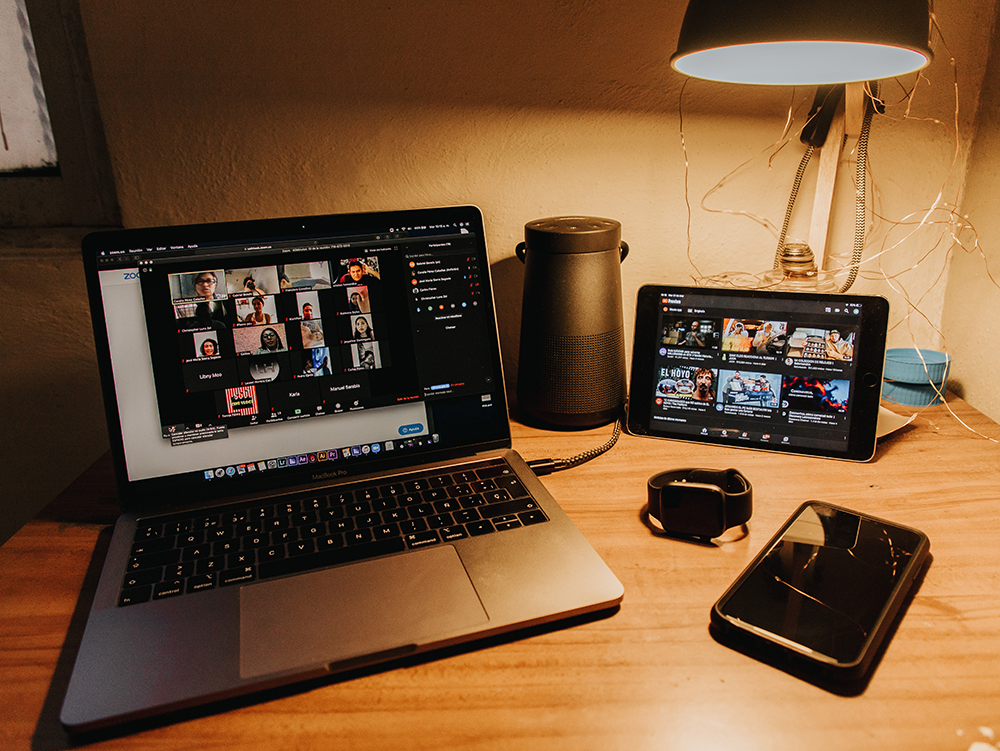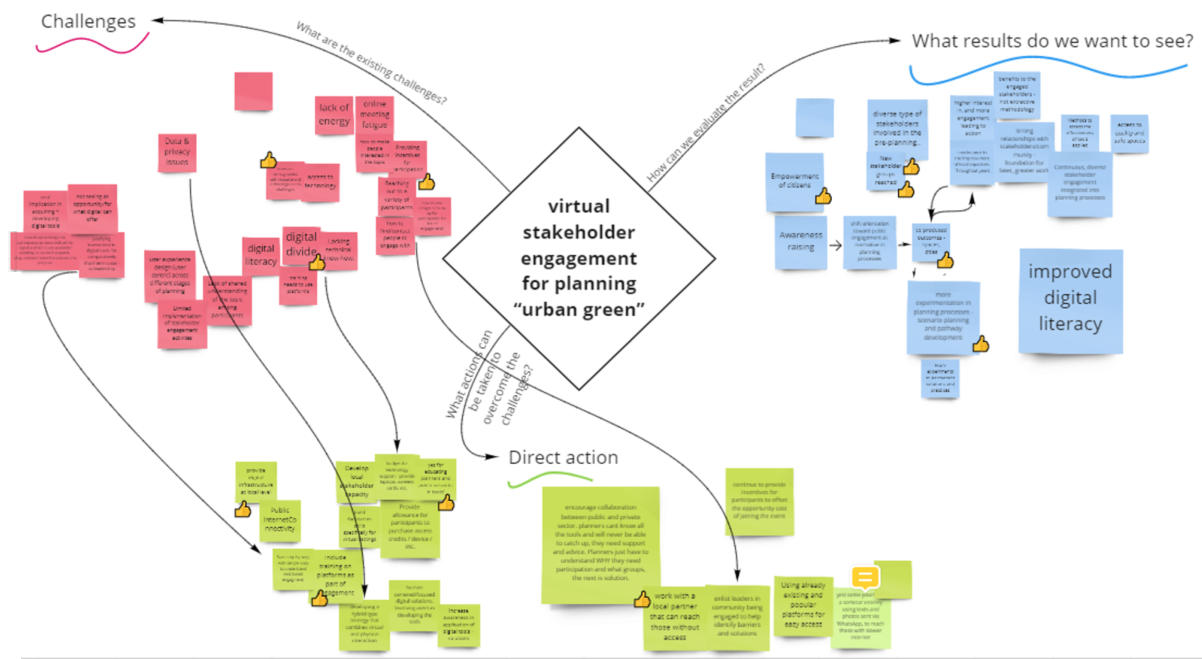Stakeholder engagement is crucial in sustainable urban planning, but the COVID-19 pandemic has made it challenging, as traditional participatory methods can pose a health risk to those involved. This has raised questions over the extent to which digital tools and platforms can bridge the gap, and what else practitioners need to be aware of when planning urban green infrastructure. During the Nature of Cities Festival 2021, we set out to crowdsource the answers.

Increasing use of digital tools to support online participatory engagement was seen during the pandemic. Photo: Gabriel Benois / Unsplash.
This perspective examines the challenges faced by planners, and proposes actions that can be taken to leverage digital participatory tools and enable more effective planning to support societal wellbeing.
We know that meaningful participation is critical when it comes to achieving socially, economically, and environmentally sustainable outcomes. In urban planning, participation and engagement are required from a variety of stakeholders including residents, public and private sector actors, and experts from a range of disciplines. With COVID-19 restrictions in place, however, creative thinking has been required to work out how to keep this participation going.
More than 25 people attended a recent interactive brainstorming session organized by SEI for the Nature of Cities Festival 2021 as a part of the projects B.Green and the SEI City Health and Wellbeing Initiative. Participants included urban planners, architects, youth engagement coordinators, and researchers.
Short presentations were delivered by different attendees on a variety of topics: the future of online platforms for participation and ethical issues related to digital engagement (SEI); interactive 3D modelling of urban green infrastructure (Forum Virium Helsinki) and recommendations for the use of extended reality use in planning (Metropolia); the use of specific tools such as online digital participation cases (Cesis, Latvia) (Vividly) and Minecraft (Block by Block Foundation); online participatory GIS resident surveys (SEI); the hybrid Design Sprint model for stakeholder participation (Forum Virium Helsinki); and Her City online toolkit (Utmaning Foundation). Although the discussion was held in the context of urban green, nature-based solutions and green infrastructure, the points that were made are all transferable to urban planning in general.
Following a series of short presentations and a participatory discussion with attendees, facilitated using an interactive whiteboard, these key points were raised:
The pandemic has highlighted the digital divide that exists to different extents in different societies. The reliance on online engagement has meant that those without access to technology or the capability to participate are excluded. To ensure both short- and long-term impacts, initiatives should focus not only on using digital technologies, but also on developing access to and capacities for the use of digital tools among local stakeholders, including planners and public sector workers.
Improving local access to technology can be achieved through the development of local digital infrastructure or by targeting resources to provide laptops and wireless cards, for example. Training in digital literacy and associated soft skills, such as facilitation, might also be required for these participatory tools and technologies to be used effectively. Overall, training in the use of digital platforms can even be seen as part of broader efforts to engage stakeholders and develop long-term relationships, as demonstrated by the uptick in the use of digital communication platforms such as Zoom. People have different levels of experience with such tools, as well as a differing willingness to experiment with them, and so a key message is to tailor the approach according to the users’ needs.
Combining different methods – digital (questionnaire) and analogue (face-to-face), for example – when engaging with participants may enable a broader group of people to be reached, while also helping to mitigate representation bias. During COVID-19, however, these face-to-face methods must ensure the health and safety of all participants. For example, in the B.Green project, partners are leveraging their contacts with staff at housing establishments for older people to support residents in answering an online survey related to the planning of nearby green infrastructure. B.Green has also organized outside field visits with stakeholders, between sets of online seminars.

On-site meetings and and online workshop sessions as part of B.Green project. Photo: Green / SEI.
In the City Health and Wellbeing Initiative, partners planned hybrid digital and physical events that local representatives could attend, keeping safe distances while benefitting from secure access to the internet and digital equipment.
The successful planning and implementation of nature-based solutions depends on gaining access to expertise about the local context. Delegating facilitation to remote partners who have been trained and who are aware of local contexts can be one way to overcome the challenges of COVID-19 travel restrictions. Involving key stakeholders, such as local community leaders, as co-developers in these processes can help to make them locally relevant and user-friendly; it can also enable the stakeholders to advocate for these engagement activities. The Block by Block Foundation, for instance, trained local staff in project countries across the globe to carry out Minecraft workshops in areas where public restrictions were not in place. This allowed them to continue with their public space planning processes from a distance.
Online engagement has become the norm for many people during COVID-19, but for some, its frequent use has had a negative effect and has made it less appealing. This means that, even though more people have both access to and the capability to use these online tools, they may need to be incentivized to do so. Planning online meetings that clearly benefit participants could help in this regard. These benefits could include improvements in personal awareness and learning about a new topic; the possibility to influence plans or agendas; or even the opportunity to enter into a prize lottery.
Digital technologies can also be used to create shared “working” environments for individuals, experts and other civil servants. In his presentation at the conference, Lauri Lemmenlehti from Forum Virium Helsinki explained how 3D models can be used as a collaborative working spaces. These can be used to communicate key information about the urban space in question and can help collaborators visualize the effects of seasonal and long-term changes in the cityscape. For example, collaboration between transport and landscape planners using 3D models can help ensure that sufficient space is provided for effective urban nature-based solutions at an early stage in the planning process, thereby avoiding potential retrofitting challenges later on.
In addition, Mette Hiltunen, also from Forum Virium Helsinki, presented the hybrid 2-day Design Sprint model used in the B.Green project. The model brought together experts, researchers, and a diverse range of planning practitioners to listen to relevant presentations, join safe outdoor fieldwork excursions, and finally come together to brainstorm ideas and designs using digital whiteboards.

Interactive whiteboards can be used as participatory tools for raising issues, clustering ideas and decision-making. Photo: SEI.
Using existing, highly accessible and popular platforms, such as Whatsapp, can also facilitate participation. One advantage of using them is that they can avoid issues with slow internet connections. A participant at the conference shared the example of a youth seminar that was held using texts and photos sent via Whatsapp and, similarly, there have been other conferences held using Twitter. While these platforms are not the most ideal way to interact, for a number of reasons, they do broaden engagement. James Delaney from the Block by Block Foundation and Tove Julin from Global Utmaning Foundation (Her City toolkit) support the use of Minecraft, a popular online game for building worlds, as it is easy to use and has widespread appeal. The aim of both organizations is to bring different viewpoints into planning, especially the youth perspective.
There is a lack of methods for assessing the effectiveness of the digital tools used in planning. We need to be clear about what it is that we want digital technologies to provide, in terms of both process and final outcome. Are we using them to visualize data about the current situation or future scenarios? Or are they intended to collect knowledge and feedback from users, instead? Do we also want them to empower users: to start discussions; increase trust in democracy; strengthen relationships between actors; and/or raise awareness about certain topics? Often, these aims are not expressed from the outset and are not met automatically. They require intervention and moderation throughout the process.
When engaging people, especially those who are vulnerable, to solicit personal information such as their location, income or behaviour, we need to ensure that data is anonymized, cannot be used to identify the respondents, and is stored securely and safely. This requires us to consider what consent might mean from a user perspective, and to make sure that we account for how representative the sample that we’re making conclusions about is. SEI’s Fiona Lambe highlighted the risk of using digital technologies to simply “extract” data from people, rather than to find actual value in engaging communities throughout the broader process, for example through study design, skills training, analysis and results sharing.
In conclusion, projects need to assess whether investing in digital tools during COVID-19 is appropriate. One consideration is whether their use, post-pandemic, will maintain or extend audience participation. Additionally, activities that increase participants’ access to and interaction with planning processes, and the knowledge and data they provide, might also have positive long-term impacts on other stakeholders, such as local communities. However, we need to keep in mind that digital technologies are not neutral and should not be used blindly. As a part of the participation palette, however, they can potentially help projects to reach a larger number of stakeholders.
Presentations made at the Nature of Cities Festival 2021
Design and development by Soapbox.
